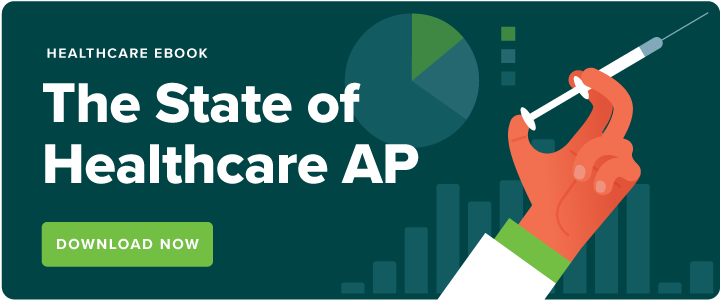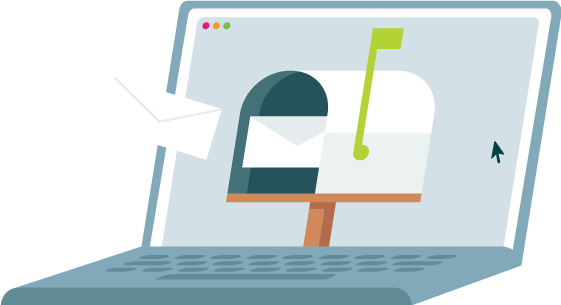State of Healthcare AP
The healthcare industry is navigating a rapidly evolving landscape, and finance teams are feeling the pressure to adapt. From rising operational costs to meeting patient expectations, healthcare accounts payable (AP) departments must find new ways to streamline processes, stay compliant, and improve overall efficiency. In 2025, the focus is shifting toward automation, data-driven decisions, and smarter payment solutions to tackle these challenges head-on. In this post, we’ll explore the latest trends in healthcare payments and how AP teams are embracing innovative solutions to stay ahead in a dynamic environment.
Key takeaways
- AI and automation are enhancing payment efficiency and reducing errors.
- Patient payment solutions are key to improving cash flow and satisfaction.
- Digital payments and automation are improving vendor relationships and reducing manual tasks.
- Data analytics is helping healthcare organizations make smarter payment decisions.
Payment and accounts payable trends for healthcare in 2025
In order to deal with healthcare AP challenges, today’s medical practices must find ways to cut costs without affecting patient care quality. This tall order falls on teams in the back office, specifically the AP team. Keep reading to learn how finance staff across the healthcare vertical are optimizing their payments and AP workflow in 2025 to benefit their entire organization amidst economic uncertainty.
Key trends shaping healthcare payment and accounts payable processes in 2025 include:
- The role of AI and automation in payment processing
- The rise of patient payment solutions
- Optimizing revenue to improve financial stability
- Increased adoption of digital tools for efficiency
- Heavy focus on document management and invoice routing
- Increased reliance on electronic payment methods
- Enhanced vendor relationship management
- Leveraging data analytics for smarter payment decisions
- Ensuring compliance and adapting to evolving regulations
1. The role of AI and automation in payment processing
As we step into 2025, the healthcare industry is increasingly turning to AI and automation to streamline payment processing. These technologies are helping finance teams work smarter, not harder. AI allows for faster data analysis, which makes invoice management more efficient, reduces errors, and cuts down on manual tasks. This not only improves accuracy, but also speeds up the overall process, enabling healthcare organizations to stay ahead in an environment where efficiency is key.
Automation isn’t just about speed; it’s about smarter operations. By integrating AI into accounts payable systems, healthcare providers can track payment statuses, forecast cash flows, and ensure compliance without the need for constant manual oversight. As organizations scale, this technology will be essential for keeping things running smoothly and cost-effectively.
2. The rise of patient payment solutions
Patients are shouldering more of their healthcare expenses with rising out-of-pocket costs and high-deductible health plans. This trend is pushing healthcare organizations to offer payment solutions that are not only flexible but also user-friendly. In 2025, digital payment solutions are becoming the norm for healthcare providers looking to enhance the patient experience while streamlining their payment collection processes.
By offering online portals, automated reminders, and multiple payment options, healthcare organizations can make it easier for patients to manage their bills. This reduces the time spent on administrative tasks while improving cash flow and patient satisfaction. It’s a win-win when patients can get the flexibility they need, and healthcare providers reduce the strain on their back-office staff.
3. Optimizing revenue will be top of mind
Inflation and supply chain issues have reduced revenue across industries, and healthcare is no exception. Leadership teams have tasked finance teams to identify areas where they can cut costs and increase revenue without compromising their customer experience. As a result, many teams this year are optimizing their internal business operations to crack down on inefficiencies.
Last year, invoice processing challenges/delays was the #1 AP challenge stemming from supply chain disruptions. This prompted many finance teams to evaluate their accounts payable workflow to identify bottlenecks and inefficiencies that result in wasted staff time and money. By fixing these problems internally, teams will maximize staff efficiency and improve their overall financial position without additional capital investments.
4. Increased adoption of digital tools
Once teams identify internal bottlenecks, many opt for digital solutions to solve the issue. For example, healthcare organizations are increasingly using AI to process insurance claims, analyze their medical record keeping, and capture invoices from vendors. Software systems and digital tools that automate repetitive and manual tasks like these will become even more commonplace in this year and beyond.
Aside from adding efficiency gains, these digital tools improve workflows by enabling hybrid-friendly digital processes and improving the employee experience for back office staff. With 30% of healthcare organizations citing staff turnover, it’s crucial that firms focus on retaining their current hires. Digital tools like AP automation software can support these efforts, while also managing additional workload. Last year 46% of healthcare AP teams reported that they were able to process more invoices with the same size team thanks to AP automation.
5. Heavy focus on document management and invoice routing
Healthcare organizations often manage a high volume of monthly payments, which can quickly eat up AP staff time and thus require a modern system to streamline traditionally manual tasks like routing invoices, filing paperwork, and organizing vendor inquiries.
With so many documents to keep track of, healthcare AP teams must prioritize having a straightforward, centralized document management system so they can easily find and store documents in a secure (and HIPAA compliant) environment. Synching your ERP system with an AP automation tool kills two birds with one stone by providing such a document management system, with the additional capabilities to automatically route all invoices for approval and payment.
6. Increased reliance on electronic payment methods
As we covered above, healthcare teams on average make more monthly payments than organizations in other industries. This high volume of invoices often also translates to more monthly inquiries from vendors. Unfortunately, 46% of healthcare AP teams spend more than 6 hours each month fielding questions from suppliers, when they could be focusing that time on more strategic and valuable endeavors. So what’s the most common type of inquiry? Requests for status of invoice/payment are the #1 vendor inquiry to healthcare AP teams.
Embracing electronic payments is one way that teams can reduce their overall inquiry volume. As one of the fastest payment methods, digital payments reduce the likelihood that vendors will need to follow up about the status of a payment. Unlike mailing and trying to track a paper check, digital payment methods provide increased visibility and a clearer payment timeline for both parties. Furthermore, digital payments are much more secure than paper checks, thereby offering increased protection against rising fraud and scam threats. These benefits are some of the main drivers that explain why 72% of healthcare teams reported wanting to make more electronic payments over the next 12 months.
7. Enhanced vendor relationship management
Managing relationships with vendors is more important than ever in 2025, as healthcare organizations continue to adopt automation in their accounts payable processes. By using digital tools to handle payment approvals and invoice processing, healthcare finance teams can focus on building stronger, more strategic relationships with vendors.
This level of transparency and efficiency strengthens vendor relationships, which can lead to better terms, discounts, and long-term partnerships. In an increasingly competitive market, streamlining vendor management through automation is a smart move for any healthcare organization looking to reduce costs and improve operational efficiency.
8. Leveraging data analytics for smarter payment decisions
As data analytics tools become more advanced, healthcare organizations are discovering the power of data to drive smarter payment decisions. By analyzing payment patterns, invoice histories, and vendor performance, finance teams can identify trends that help them predict payment needs more accurately and optimize their cash flow.
In 2025, it’s crucial for healthcare finance teams to move beyond basic reporting and adopt predictive analytics to make better decisions regarding payments and budgeting. With the right data, teams can anticipate payment timing, uncover inefficiencies in the AP workflow, and even negotiate better terms with vendors based on historical payment performance. By integrating these data-driven insights into their accounts payable strategies, healthcare organizations can reduce costs and avoid payment delays, all while ensuring the sustainability of their operations.
9. Ensuring compliance and adapting to evolving regulations
As healthcare regulations continue to evolve, staying compliant is more critical than ever. In 2025, organizations are increasingly focused on aligning their AP processes with the latest regulatory requirements, from billing practices to patient privacy protection. The ability to seamlessly integrate compliance measures into payment systems is vital for minimizing risk and maintaining trust with patients and stakeholders.
Automating AP processes can play a crucial role in this area. With automated tools, healthcare organizations can ensure that all payments are processed in compliance with HIPAA, as well as other state and federal regulations, without burdening staff with manual checks. This not only saves time but also helps protect sensitive patient and financial data from potential breaches. As healthcare providers continue to navigate complex regulations, adopting solutions that ensure compliance across the board will be essential for future success.
The future of healthcare AP and how Mineraltree can help
While the current industry conditions may seem bleak for healthcare organizations, they also provide a unique opportunity for those in the vertical to reimagine a new, modern way to work. McKinsey and Company notes that this depends on current industry leaders’ ability to “redesign their organizations for speed, accelerate productivity improvements, reshape their portfolios, innovate with new business models, and reallocate constrained resources.” Prioritizing digital transformation and internal process improvements is a strong step in the right direction. Along the way, teams will minimize inefficiencies, engage staff, and become an overall more strategic organization.
Mineraltree offers the tools healthcare organizations need to thrive in this new landscape. By automating invoice processing, routing approvals, and enabling secure digital payments, Mineraltree simplifies AP workflows and helps organizations stay ahead of industry trends. With the right digital solutions in place, healthcare finance teams can focus on strategic initiatives while ensuring their payment processes are fast, secure, and cost-effective.
Looking to learn more about how finance teams in the healthcare industry team are strategizing for 2025? Download our State of Healthcare AP eBook by clicking the banner below.

Healthcare payments trends FAQs
Tl;dr? If you’re short on time, the frequently asked questions below provide a quick snapshot of what you need to know about healthcare payments.
How can healthcare organizations reduce payment delays in AP?
Payment delays are often a result of manual processes and bottlenecks. By implementing automated AP solutions, healthcare organizations can speed up the approval process, ensure timely payment to vendors, and reduce delays caused by manual invoice processing and approval workflows.
What challenges do healthcare organizations face when adopting AP automation?
While AP automation offers significant benefits, healthcare organizations may face challenges such as initial implementation costs, employee training, and integration with existing systems. However, these challenges can be mitigated with the right vendor partnership and proper change management strategies.
What role does cloud-based AP automation play in healthcare organizations?
Cloud-based AP automation allows healthcare organizations to access their payment data anytime, anywhere, making it easier to manage invoices and approvals remotely. It also ensures that systems are continuously updated with the latest features and security measures, providing flexibility and scalability as organizations grow.



